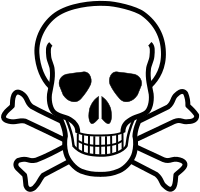Thomas Larimore
Thomas Larimore (fl. 1677-1706, last name occasionally Laramore, Larrimore, Laremore, Laremoor) was a privateer and pirate active in the Caribbean and off the eastern seaboard of the American colonies. After helping suppress Bacon’s Rebellion and serving as a militia leader he turned to piracy, operating alongside John Quelch.
History
When Nathaniel Bacon rebelled against Virginia colonial officials in 1676, Larimore sided with the Virginia loyalists under Governor William Berkeley.[1] He ferried troops and fought in and around Newport News in his ship Rebecca, which was captured by Bacon’s rebels then recaptured and returned to Larimore.[2] He then used the Rebecca – with extra cannon added by the rebels – to capture the rebels’ remaining ships, helping lead the loyalists to victory.[1]
Larimore also served as quartermaster aboard several different vessels during King William's War from 1688-1697.[3] In 1702 he was commissioned as a privateer by Governor Joseph Dudley of Boston to sail against the French, and took at least five French ships. Dudley commissioned Larimore again in 1703, this time to lead a unit of foot soldiers to help defend Jamaica against the Spanish.[4] His soldiers suffered from disease and went unpaid, shuffled around the Caribbean and as far north as Newfoundland before being returned to Boston that November.[4]
Bitter and broke, Larimore took to piracy on his ship Larimore Galley alongside pirate John Quelch.[3] They returned to the Caribbean, plundering several Portuguese ships, even after England and Portugal had become allies. Returning to Cape Ann near Boston, a number of Quelch’s men came aboard Larimore’s ship, from which they dispersed on shore to hide their loot.[5] Governor Dudley’s men seized Larimore, his crew, and the remains of Quelch’s crew. Larimore was sent to England for trial, but because of his service against the French and Spanish, Dudley asked officials to pardon him.[5] By late 1706 Larimore had been returned to Plymouth and again placed under arrest, “suspected of very ill designs and practices.”[6]
See Also
- Admiralty court, the venue in which Larimore's privateering prizes were approved, and in which Larimore was later tried.
References
- 1 2 Webb, Stephen Saunders (1995). 1676: The End of American Independence. Syracuse NY: Syracuse University Press. ISBN 9780815603610. Retrieved 1 August 2017.
- ↑ Jameson, John Franklin (1923). Privateering and Piracy in the Colonial Period by J. Franklin Jameson. New York: Macmillan. Retrieved 26 June 2017.
- 1 2 Beal, Clifford (2007). Quelch's Gold: Piracy, Greed, and Betrayal in Colonial New England. Westport CT: Greenwood Publishing Group. ISBN 9780275994075. Retrieved 1 August 2017.
- 1 2 Matthews, Albert (1917). Publications of the Colonial Society of Massachusetts. Boston: The Society. Retrieved 1 August 2017.
- 1 2 Hanna, Mark G. (2015). Pirate Nests and the Rise of the British Empire, 1570-1740. Chapel Hill NC: UNC Press Books. ISBN 9781469617954. Retrieved 1 August 2017.
- ↑ Office, Great Britain Public Record; Fortescue, Sir John William (1916). Calendar of State Papers, Colonial Series ... London: Longman, Green, Longman & Roberts.
